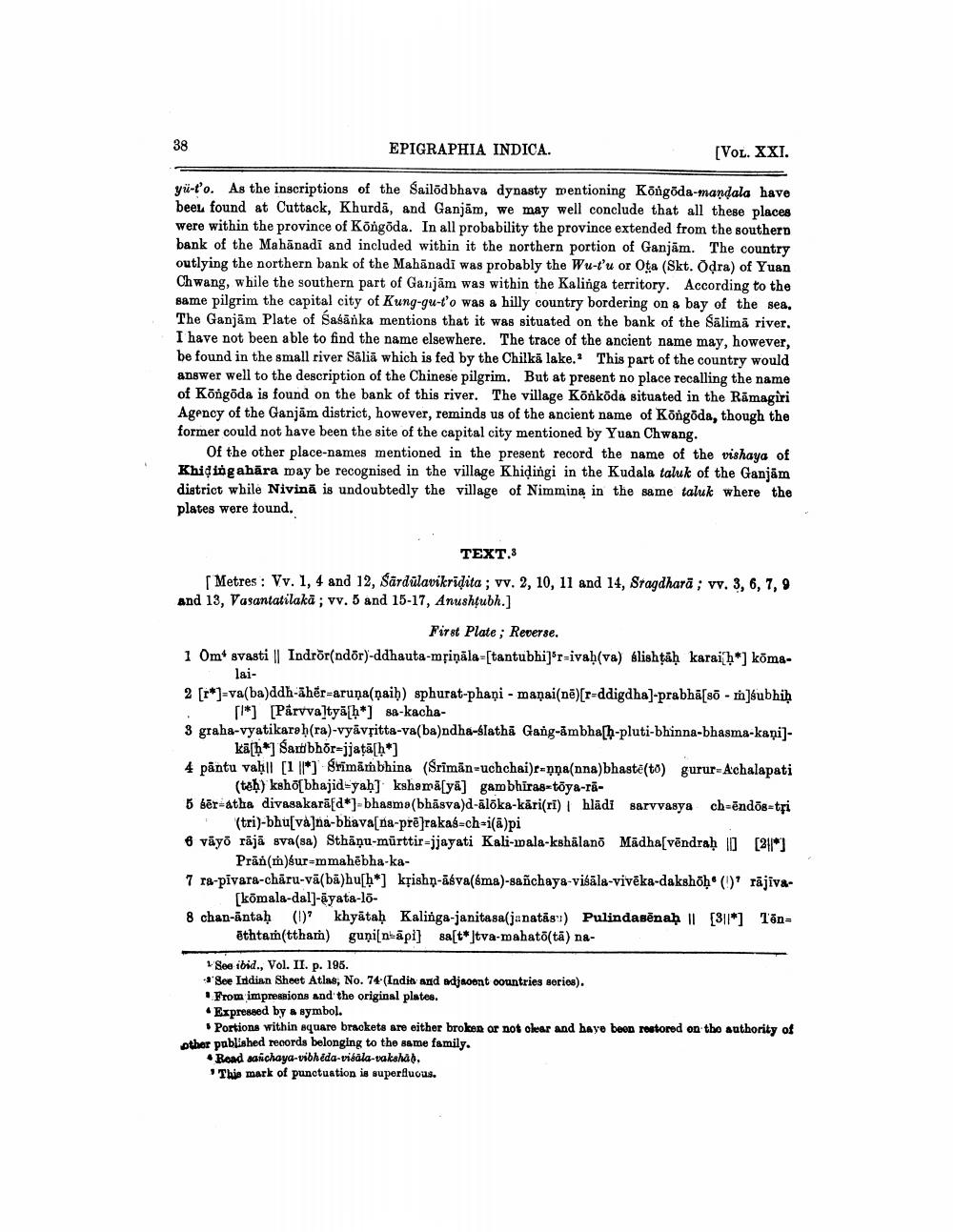________________
EPIGRAPHIA INDICA.
(VOL. XXI.
yü-t'o. As the inscriptions of the Sailodbhava dynasty mentioning Köngöda-mandala have been found at Cuttack, Khurda, and Ganjām, we may well conclude that all these places were within the province of Kõngöda. In all probability the province extended from the southern bank of the Mahānadi and included within it the northern portion of Ganjam. The country outlying the northern bank of the Mahanadi was probably the Wu-t'u or Ota (Skt. Odra) of Yuan Chwang, while the southern part of Ganjam was within the Kalinga territory. According to the same pilgrim the capital city of Kung-gu-t'o was a hilly country bordering on a bay of the sea. The Ganjām Plate of Saśānka mentions that it was situated on the bank of the Sālimā river. I have not been able to find the name elsewhere. The trace of the ancient name may, however, be found in the small river Salia which is fed by the Chilka lake. This part of the country would answer well to the description of the Chinese pilgrim. But at present no place recalling the name of Kõngoda is found on the bank of this river. The village Kõnkoda situated in the Rāmagiri Agency of the Ganjām district, however, reminds us of the ancient name of Kõngõda, though the former could not have been the site of the capital city mentioned by Yuan Chwang.
Of the other place-names mentioned in the present record the name of the vishaya of Khiqingahära may be recognised in the village Khidingi in the Kudala taluk of the Ganjam district while Nivinā is undoubtedly the village of Nimmina in the same taluk where the plates were found.
TEXT.3
Metres: Vv. 1, 4 and 12, Sardūlavikridita ; vv. 2, 10, 11 and 14, Sragdharā ; vv. 3, 6, 7, 9 and 13, Vasantatilaka ; vv. 5 and 15-17, Anushtubh.]
First Plate ; Reverse. 1 Om svasti || Indrõr(ndor)-ddhauta-msiņāla-[tantubhi]ør-ivah(va) Slishțāḥ karai b*] koma
lai2 [*]-va(ba)ddh-āhér=aruņaņaih) sphurat-phaņi - maņai(nē)[r-ddigdha)-prabhā[s7 - Jubhiḥ
[1] [Parvvaltyä h*] sa-kacha3 graha-vyatikarph(ra)-vyāvsitta-va(ba)ndha-slathā Gang-ambhalb-pluti-bhinna-bhasma-kaņi)
ka[h*] Saxt bhor=jjat[h*] 4 päntu vahll [11] Srimär bhina (Srimān=uchchair-nnanna)bhastē(to) gurur-Achalapati
(toh) kshö[bhajid=yah) kshamāsya] gambhiras-töya-ra5 bēr=atha divasakarā[d*]-bhasma(bhāsva)d-aloka-käri(ri) i hlādi sarvvasya ch=ēndās=tfi
(tri)-bhu[va]na-bhavana-prē]rakas-ch=i(ā)pi 6 vāyo rājā sva(sa) Sthāņu-mūrttir-jjayati Kali-wala-kshālano Mādha(vēndraḥ II (211)
Prān(m)sur-mmahēbha-ka7 Ta-pivara-chāru-vā(bā)hu[h*] křishn-āśva(sma)-sanchaya-visāla-vivēka-dakshoho (O' rājiva
[kömala-dal]-āyata-lo8 chan-āntah (1) khyātaḥ Kalinga-janitasa(janatas :) Pulindasēna) || [311*] Tõn=
athtam(ttham) guņi[n-āpi) sa[t*]tva-mahato(tā) na
1 See ibid., Vol. II. p. 195.
See Indian Sheet Atlas, No. 74 (India and adjacent countries series). From impressions and the original plates. • Expressed by a symbol.
Portions within square brackets are either broken or not clear and have beon restored on the authority of other published records belonging to the same family.
• Bead sahichaya-vibhéda-višala-vakshao.
This mark of punctuation is superfluous.




